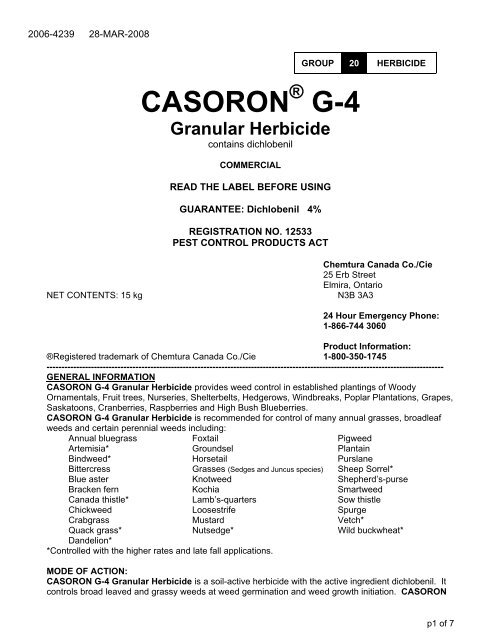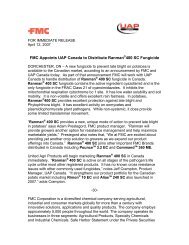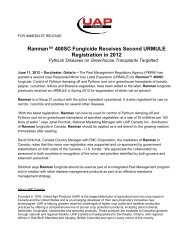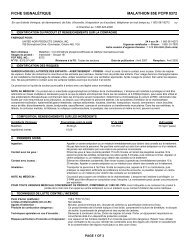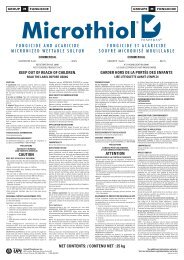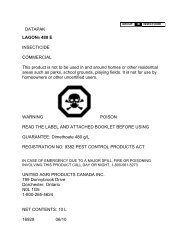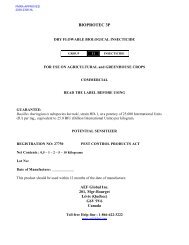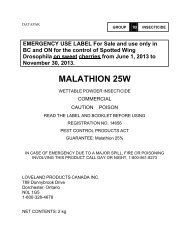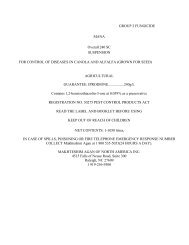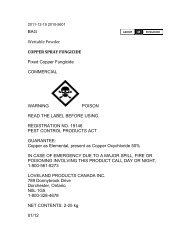CASORON ® G-4 Granular Herbicide - True North Specialty Products
CASORON ® G-4 Granular Herbicide - True North Specialty Products
CASORON ® G-4 Granular Herbicide - True North Specialty Products
Create successful ePaper yourself
Turn your PDF publications into a flip-book with our unique Google optimized e-Paper software.
2006-423928-MAR-2008<br />
GROUP 20 HERBICIDE<br />
<strong>CASORON</strong> ® G-4<br />
<strong>Granular</strong> <strong>Herbicide</strong><br />
contains dichlobenil<br />
COMMERCIAL<br />
READ THE LABEL BEFORE USING<br />
GUARANTEE: Dichlobenil 4%<br />
REGISTRATION NO. 12533<br />
PEST CONTROL PRODUCTS ACT<br />
NET CONTENTS: 15 kg<br />
Chemtura Canada Co./Cie<br />
25 Erb Street<br />
Elmira, Ontario<br />
N3B 3A3<br />
24 Hour Emergency Phone:<br />
1-866-744 3060<br />
Product Information:<br />
®Registered trademark of Chemtura Canada Co./Cie 1-800-350-1745<br />
--------------------------------------------------------------------------------------------------------------------------------------<br />
GENERAL INFORMATION<br />
<strong>CASORON</strong> G-4 <strong>Granular</strong> <strong>Herbicide</strong> provides weed control in established plantings of Woody<br />
Ornamentals, Fruit trees, Nurseries, Shelterbelts, Hedgerows, Windbreaks, Poplar Plantations, Grapes,<br />
Saskatoons, Cranberries, Raspberries and High Bush Blueberries.<br />
<strong>CASORON</strong> G-4 <strong>Granular</strong> <strong>Herbicide</strong> is recommended for control of many annual grasses, broadleaf<br />
weeds and certain perennial weeds including:<br />
Annual bluegrass Foxtail Pigweed<br />
Artemisia* Groundsel Plantain<br />
Bindweed* Horsetail Purslane<br />
Bittercress Grasses (Sedges and Juncus species) Sheep Sorrel*<br />
Blue aster Knotweed Shepherd’s-purse<br />
Bracken fern Kochia Smartweed<br />
Canada thistle* Lamb’s-quarters Sow thistle<br />
Chickweed Loosestrife Spurge<br />
Crabgrass Mustard Vetch*<br />
Quack grass* Nutsedge* Wild buckwheat*<br />
Dandelion*<br />
*Controlled with the higher rates and late fall applications.<br />
MODE OF ACTION:<br />
<strong>CASORON</strong> G-4 <strong>Granular</strong> <strong>Herbicide</strong> is a soil-active herbicide with the active ingredient dichlobenil. It<br />
controls broad leaved and grassy weeds at weed germination and weed growth initiation. <strong>CASORON</strong><br />
p1 of 7
G-4 <strong>Granular</strong> <strong>Herbicide</strong> inhibits cell growth at the growing points or meristematic tissues of the plant.<br />
Weed germination and growth initiation is strongly affected. Under certain environmental conditions<br />
Dichlobenil can be volatile. It is recommended that <strong>CASORON</strong> G-4 <strong>Granular</strong> <strong>Herbicide</strong> be applied<br />
when the temperature is less than 15°C. Applying at higher temperatures may reduce its herbicidal<br />
activity. Water is necessary to move the compound into the soil. <strong>CASORON</strong> G-4 <strong>Granular</strong> <strong>Herbicide</strong><br />
will stay in the upper 10 cm of soil and will not harm established plants with a well-developed root<br />
system below this herbicide barrier.<br />
RESISTANCE MANAGEMENT RECOMMENDATIONS:<br />
For resistance management, <strong>CASORON</strong> G-4 <strong>Granular</strong> <strong>Herbicide</strong> is a Group 20 herbicide. Any weed<br />
population may contain or develop plants naturally resistant to <strong>CASORON</strong> G-4 <strong>Granular</strong> <strong>Herbicide</strong><br />
and other Group 20 herbicides. The resistant biotypes may dominate the weed population if these<br />
herbicides are used repeatedly in the same field. Other resistance mechanisms that are not linked to<br />
site of action, but specific for individual chemicals, such as enhanced metabolism, may also exist.<br />
Appropriate resistance-management strategies should be followed.<br />
To delay herbicide resistance:<br />
• Where possible, rotate the use of <strong>CASORON</strong> G-4 <strong>Granular</strong> <strong>Herbicide</strong> or other Group 20 herbicides<br />
with different herbicide groups that control the same weeds in a field.<br />
• Use tank mixtures with herbicides from a different group when such use is permitted.<br />
• <strong>Herbicide</strong> use should be based on an IPM program that includes scouting, historical information<br />
related to herbicide use and crop rotation, and considers tillage (or other mechanical), cultural,<br />
biological and other chemical control practices.<br />
• Monitor treated weed populations for resistance development.<br />
• Prevent movement of resistant weed seeds to other fields by cleaning harvesting and tillage<br />
equipment and planting clean seed.<br />
• Contact your local extension specialist or certified crop advisors for any additional pesticide<br />
resistance-management and/or integrated weed-management recommendations for specific crops and<br />
weed biotypes.<br />
• For further information or to report suspected resistance, contact Chemtura Canada Co./Cie at 1-800-<br />
350-1745 or at www.chemtura.com.<br />
DIRECTIONS FOR USE:<br />
<strong>CASORON</strong> G-4 <strong>Granular</strong> <strong>Herbicide</strong> is a ready to use granular product. It can be spread on the soil<br />
surface by hand, using small hand held or backpack equipment, or by larger and tractor mounted<br />
spreaders. Soil should be moist after application to activate the product. A light precipitation after<br />
application to moist soil is preferred. When a dry period is expected after application, incorporate or<br />
water in the product. Covering with moist mulch is also effective.<br />
Annual Weed Control: Apply <strong>CASORON</strong> G-4 <strong>Granular</strong> <strong>Herbicide</strong> to well prepared weed-free soil in<br />
early spring or late fall before annual weed seeds have germinated. If annual weeds have started to<br />
germinate before application cultivate to remove them. Apply granules uniformly over the soil surface.<br />
Do not apply until 4 weeks after transplanting any crop. <strong>CASORON</strong> G-4 <strong>Granular</strong> <strong>Herbicide</strong> should<br />
not be applied during periods when the soil temperature is high. These usually occur when air<br />
temperatures are greater than 15°C.<br />
For use on agricultural crops:<br />
Do not enter or allow worker entry into treated areas within 12 hours of application.<br />
For horticultural/nursery uses:<br />
Do not enter or allow worker entry into treated areas within 24 hours of application.<br />
DO NOT apply by air.<br />
p2 of 7
RATE OF APPLICATION:<br />
Apply 110-175 kilograms of <strong>CASORON</strong> G-4 <strong>Granular</strong> <strong>Herbicide</strong> per hectare. The amount of<br />
<strong>CASORON</strong> G-4 <strong>Granular</strong> <strong>Herbicide</strong> used should be based on the area actually treated. Do not use<br />
on light sandy soil. Lower rates on this label can be used if application is followed immediately by an<br />
application of 1.3 to 2.5 centimeters of water by overhead irrigation. Use the high rate in the use range<br />
only every other year.<br />
Treating smaller areas or calibrating:<br />
<strong>CASORON</strong> G-4 <strong>Granular</strong> <strong>Herbicide</strong> per<br />
Area Treated<br />
Hectare 1mx1m 1.5mx1.5m 2mx2m 2.5mx2.5m 3mx3m<br />
110 kg 11 gm 25 gm 45 gm 70 gm 100 gm<br />
175 kg 17 gm 40 gm 70 gm 110 gm 160 gm<br />
ESTABLISHED PLANTINGS OF WOODY ORNAMENTALS, NURSERIES AND SHELTERBELTS*,<br />
HEDGEROWS AND WINDBREAKS*: <strong>CASORON</strong> G-4 <strong>Granular</strong> <strong>Herbicide</strong> may be used for annual<br />
weed control with repeat applications each year at the lower rate for maintenance weed control. Use<br />
the high rate (175 Kg / Ha) to control grasses and tough perennial weeds every other year at most.<br />
The lower rate, 110 Kg/Ha can be used the following year for annual weed control. Follow directions<br />
listed above. Apply by ground only.<br />
<strong>CASORON</strong> G-4 <strong>Granular</strong> <strong>Herbicide</strong> may be used for weed control on the plants listed below.<br />
Follow application directions.<br />
Arborvitae Elm Locust<br />
Ash Euonymus Maple<br />
Barberry Forsythia sp. Mock orange<br />
Birch (Cut Leaf Weeping) Heather Poplars<br />
Boxwood Holly (Ilex spp.)† Rhododendron<br />
Caragana Honeysuckle Rose<br />
Cedar (Eastern Red) Juniper Spirea<br />
Cedar (White) Lilac Willow<br />
Crabapple Linden Yew (Taxus)<br />
* only trees listed above should make up the Shelterbelts, Hedgerows, Windbreaks<br />
† Holly (Ilex spp. Except I. crenata, I. rotunda, I vomitoria)<br />
Note: Do not use on:<br />
Gladiolus<br />
Firs (Abies species such as Balsam Fir [Abies concolour])<br />
Ajuga Ilex crenata Hemlock<br />
Ilex rotunda Ilex vomitoria Spruce<br />
Herbaceous Perennials† Mugho pine<br />
† avoid use on plants which die down to the ground in the fall<br />
use with caution on shallow rooted ground covers (Euonymus can be treated), and other plants from<br />
list above.<br />
CONTAINER NURSERY STOCK: Apply <strong>CASORON</strong> G-4 <strong>Granular</strong> <strong>Herbicide</strong> at 100 kg per hectare.<br />
Water in immediately after application. Apply by ground only.<br />
For use on these specific species:<br />
Juniper<br />
- Juniperus chinensis<br />
- Juniperus horizontalis<br />
Eastern White Cedar - Thuja occidentalis<br />
For the control of the weeds mentioned earlier on this label plus Bittercress.<br />
Note: Observe these use guidelines.<br />
p3 of 7
DO NOT USE IN OR NEAR GREENHOUSES<br />
Wait to apply <strong>CASORON</strong> G-4 <strong>Granular</strong> <strong>Herbicide</strong> for at least four (4) weeks after transplanting into<br />
containers. Use only on established container plants growing outside in the open air. Do not use in<br />
seedbeds, transplant or cutting beds or in greenhouses. Do not use after September 15 or within thirty<br />
(30) days of potting treated stock into a container holding house as damage to the crop may occur.<br />
Use only on potting mixes that have a minimum of 80% pure organic matter. Lower amount of organic<br />
matter may increase risk of injury to the crop.<br />
Only small numbers of containers should be treated until a grower has experience with this application.<br />
For further information contact provincial government authorities.<br />
FRUIT TREES AND FRUIT TREE NURSERIES:<br />
<strong>CASORON</strong> G-4 <strong>Granular</strong> <strong>Herbicide</strong> may be used for weed control around bearing fruit trees and<br />
established second year orchard stock of the following:<br />
APPLE, CHERRY, PEACH, PEAR, AND PLUM. Follow directions for broadcast or band (herbicide<br />
strip) tree area only application. Refer to precautions for timing with transplants.<br />
Do not apply to trees within 3 months either before or after grafting or budding of root stocks or planting<br />
of new grafts. Do not apply more than the maximum recommended amount per growing season. Apply<br />
by ground only.<br />
NEWLY PLANTED APPLE TREES: (in British Columbia only). May be treated with <strong>CASORON</strong> G-4<br />
<strong>Granular</strong> <strong>Herbicide</strong> four weeks after new trees are planted in the orchard but prior to weed growth.<br />
Apply 110-175 kg per hectare total per season. Use the lower rate on lighter soils. Use the high rate in<br />
the use range only every other year. Under warm growing conditions, immediately after application of<br />
the <strong>CASORON</strong> G-4 <strong>Granular</strong> <strong>Herbicide</strong> apply 1.3-2.5 cm of water by overhead irrigation. Do not apply<br />
by air.<br />
POPLAR PLANTATIONS: For control of many annual grasses, broadleaf weeds and certain perennial<br />
weeds as listed in Directions for Use section. <strong>CASORON</strong> G-4 <strong>Granular</strong> <strong>Herbicide</strong> should be applied to<br />
poplar plantations by ground only. Apply 110-174 kg <strong>CASORON</strong> G-4 <strong>Granular</strong> <strong>Herbicide</strong> per hectare,<br />
once per season. Apply uniformly over the soil surface. Do not use on trees established less than 6<br />
months. Apply in late fall or early spring when poplar plants are dormant (or pre-bud break). Do not<br />
plant crops not registered for use with <strong>CASORON</strong> G-4 <strong>Granular</strong> <strong>Herbicide</strong> in treated soil within one<br />
year after application.<br />
CRANBERRIES: Control of annual broad leaved species, Blue Aster, Loosestrife, Horsetail,<br />
Knotweed, Plantain, Smartweed and Grasses (certain Sedges and Juncus Species). Application should be<br />
made early in the spring while perennial weeds are still dormant and annual weeds have not started to<br />
germinate, apply pre-bloom.<br />
SPRING APPLICATION: Apply 110 kilograms <strong>CASORON</strong> G-4 <strong>Granular</strong> <strong>Herbicide</strong> per hectare. Do<br />
not make a spring application after application the previous fall. See specific directions for British<br />
Columbia.<br />
BRITISH COLUMBIA: Apply 175 - 225 kilograms <strong>CASORON</strong> G-4 <strong>Granular</strong> <strong>Herbicide</strong> per hectare in<br />
two equal applications in early spring with an interval of 3 to 6 weeks between each 90 - 110 kilograms<br />
per hectare treatment. Use the high rate in the use range only every other year. Do not make fall<br />
applications.<br />
Note: Distribute granules evenly. Avoid over application which may result from overlapping during<br />
treatment. Temporary reddening of Cranberry plants may occur, especially with late spring<br />
applications. Do not apply after Cranberry plants start to bloom as yield may be reduced. Do not use<br />
on young beds, newly sanded beds or beds recently mowed for vines. Use lower rates of application<br />
on sandy bogs.<br />
HIGHBUSH BLUEBERRIES: Apply uniformly at the rate of 175 - 225 kilograms per hectare during the<br />
dormant period (late winter) Bracken fern and weeds listed in the cranberry section of this label will be<br />
controlled. Use the high rate in the use range only every other year. Apply by ground only.<br />
p4 of 7
RASPBERRIES: For couch grass, other perennial broadleaf weeds and annual weeds in established<br />
raspberry plantings. Apply <strong>CASORON</strong> G-4 <strong>Granular</strong> <strong>Herbicide</strong> at the rate of 175 kilograms per<br />
hectare in late fall. Use this rate only every other year. Do not cultivate or work into the soil. Do not<br />
apply in the spring as injury may occur. Alternate herbicides to avoid weed resistance. Use with<br />
caution on new varieties. Apply by ground only.<br />
ESTABLISHED SASKATOONS: Weeds controlled - as per above list including chickweed, stinkweed,<br />
groundsel, pigweed, dandelion and some grasses. Apply to Saskatoons, established for one or more<br />
years. Apply with a granular applicator in the fall before freeze-up. Use 110-175 kg of <strong>CASORON</strong> G-4<br />
<strong>Granular</strong> <strong>Herbicide</strong> granules per hectare on a broadcast basis. Use the high rate in the use range<br />
only every other year. Do not apply within 9 months of harvest. Apply by ground only.<br />
GRAPES: Apply only to control weeds under grapes established for at least two full years. Do not<br />
treat soil the year before planting or replanting grapes. Grape nurseries should not be treated.<br />
Rates: For seedling weeds use 110 - 175 kilograms per hectare in early spring or fall. For perennial<br />
weeds such as couch grass and thistles, apply in the fall using 175-225 kilograms per hectare. Use the<br />
high rate in the use range only every other year. Apply by ground only.<br />
Follow these specific recommendations.<br />
1. Treat when vines are completely dormant.<br />
2. Treat only healthy vines.<br />
3. Treat only vines established for at least two full years.<br />
4. Apply in cool weather on moist soil.<br />
5. Avoid over-application to base of the stem.<br />
Note: If spring application is made, apply before the weeds germinate and a month before the grape<br />
buds burst. Do not apply on hazy, hot days.<br />
COUCH GRASS AND ARTEMISIA CONTROL IN ESTABLISHED WOODY ORNAMENTALS: Couch<br />
grass and Artemisia can be controlled in woody ornamentals listed above (except Boxwood,<br />
Euonymus, Forsythia, Heather) which has been planted for at least one year - and for control in noncrop<br />
areas. Uniformly apply 150 kilograms per hectare <strong>CASORON</strong> G-4 <strong>Granular</strong> <strong>Herbicide</strong> in late fall<br />
(between October 15th and December 15th) and reapply at the rate of 150 kilograms per hectare in<br />
very early spring (before May 1). Do not repeat this application the next year. Apply by ground only.<br />
QUACKGRASS, THISTLES, BINDWEED, DANDELION: Fall treat the areas of weeds from spring<br />
plantings of woody ornamentals. Uniformly apply 225 -275 kilograms of <strong>CASORON</strong> G-4 <strong>Granular</strong><br />
<strong>Herbicide</strong> per hectare in late October or November. DO NOT TRANSPLANT INTO TREATED SOIL<br />
FOR ONE YEAR. Apply by ground only.<br />
NUTSEDGE (NUTGRASS) CONTROL: To control Nutsedge (Nutgrass) on mineral soils in areas on<br />
which containers of nursery stock are to be grown or held - also for control on cultivated non-crop land -<br />
apply 275 kilograms <strong>CASORON</strong> G-4 <strong>Granular</strong> <strong>Herbicide</strong> per hectare and incorporate immediately to a<br />
depth of 10 to 15 centimeters. Seasonal control of annual weeds will also be obtained. Containers of<br />
plants listed above may be placed on treated soil immediately. DO NOT TRANSPLANT INTO<br />
TREATED SOIL FOR ONE YEAR. Apply by ground only.<br />
PRECAUTIONS:<br />
• KEEP OUT OF REACH OF CHILDREN. Harmful if swallowed. Avoid breathing dust. Avoid skin or<br />
eye contact. Avoid contamination of feed and foodstuffs.<br />
• Do not use crops other than those listed on the label. Do not use in seedbeds, transplant or cutting<br />
beds. DO NOT USE IN OR AROUND GREENHOUSES.<br />
• Do not apply until 6 months after rooting of cuttings in the field.<br />
p5 of 7
• CAUTION: Do not graze livestock in treated areas or use treated crops for forage or fodder,<br />
sufficient data are not available to support such use. Application in spring should be made well<br />
before bud burst. Do not plant vegetables or other sensitive crops the year following soil treatment.<br />
• Wear long pants and a long-sleeved shirt, shoes and socks during mixing/loading and application. In<br />
addition, wear chemical resistant gloves during mixing/loading, clean-up and repair activities.<br />
• Do not apply directly by hand.<br />
• DO NOT APPLY BY AIR.<br />
If this pest control product is to be used on a commodity that may be exported to the U.S. and you<br />
require information on acceptable residue levels in the U.S., visit CropLife Canada's web site<br />
at: www.croplife.ca.<br />
ENVIRONMENTAL HAZARDS<br />
• This chemical demonstrates the properties and characteristics associated with chemicals<br />
detected in groundwater. The use of this chemical may result in contamination of groundwater,<br />
particularly in areas where soils are permeable and/or the water table is shallow.<br />
• To reduce runoff from treated areas into aquatic habitats, consider the characteristics and conditions<br />
of the site before treatment. Site characteristics and conditions that may lead to runoff include, but<br />
are not limited to, heavy rainfall, moderate to steep slope, bare soil, poorly draining soil (e.g., soils<br />
that are compacted, fine textured or low in organic matter such as clay)<br />
• Avoid application of this product when heavy rain is forecast.<br />
FIRST AID:<br />
If swallowed: call a poison control centre or doctor immediately for treatment advice. Have a<br />
person sip a glass of water if able to swallow. Do not induce vomiting unless told to do so by a<br />
poison control centre or doctor. Do not give anything by mouth to an unconscious person.<br />
If inhaled: move person to fresh air. If person is not breathing, call 911 or an ambulance, then<br />
give artificial respiration, preferably by mouth-to-mouth, if possible. Call a poison control centre<br />
or doctor for further treatment advice.<br />
If on skin or clothing: take off contaminated clothing. Rinse skin immediately with plenty of<br />
water for 15 - 20 minutes. Call a poison control centre or doctor for treatment advice.<br />
If in eyes: hold eye open and rinse slowly and gently with water for 15 - 20 minutes. Remove<br />
contact lenses, if present, after the first 5 minutes, then continue rinsing eye. Call a poison<br />
control centre or doctor for treatment advice<br />
Take container, label or product name and Pest Control Product Registration Number with you when<br />
seeking medical attention.<br />
TOXICOLOGICAL INFORMATION: Treat symptomatically.<br />
STORAGE AND DISPOSAL:<br />
STORAGE: Store product in original container only, away from other pesticides, fertilizer, food or feed.<br />
Keep container closed. Do not store in direct sunlight. Do not store above 35°C or below 0°C.<br />
DISPOSAL:<br />
1. Follow provincial instructions for any required cleaning of the container prior to its disposal.<br />
2. Make the empty container unsuitable for further use.<br />
3. Dispose of the container in accordance with provincial requirements.<br />
p6 of 7
4. For information on the disposal of unused, unwanted product, contact the manufacturer or the<br />
provincial regulatory agency. Contact the manufacturer and the provincial regulatory agency in case<br />
of a spill, and for clean-up of spills.<br />
NOTICE TO USER: This pest control product is to be used only in accordance with the<br />
directions on the label. It is an offence under the Pest Control <strong>Products</strong> Act to use this product<br />
in a way that is inconsistent with the directions on the label. The user assumes the risk to<br />
persons or property that arises from any such use of this product.<br />
ID#-12533-E-071122<br />
p7 of 7
******************************<br />
This label transcript service is offered by the Pest Management Regulatory Agency to provide<br />
efficient searching for label information. This service and this information do not replace the<br />
official hard-copy label. The PMRA does not provide any guarantee or assurance that the<br />
information obtained through this service is accurate, current or correct, and is therefore not<br />
liable for any loss resulting, directly or indirectly, from reliance upon this service.


